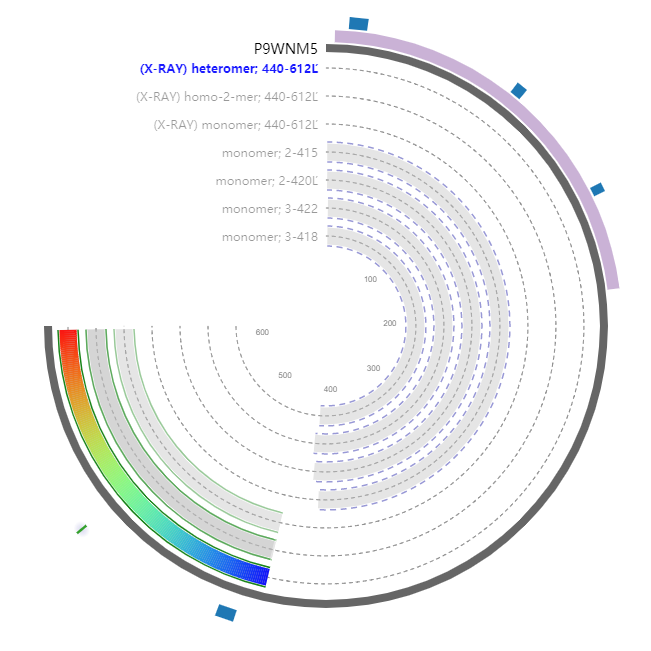ATP sulfurylase may be the GTPase, regulating ATP sulfurylase activity.This protein is involved the subpathway that synthesizes sulfite from sulfate.
MTTLLRLATAGSVDDGKSTLIGRLLYDSKAVMEDQWASVEQTSKDRGHDYTDLALVTDGL
RAEREQGITIDVAYRYFATPKRKFIIADTPGHIQYTRNMVTGASTAQLVIVLVDARHGLL
EQSRRHAFLASLLGIRHLVLAVNKMDLLGWDQEKFDAIRDEFHAFAARLDVQDVTSIPIS
ALHGDNVVTKSDQTPWYEGPSLLSHLEDVYIAGDRNMVDVRFPVQYVIRPHTLEHQDHRS
YAGTVASGVMRSGDEVVVLPIGKTTRITAIDGPNGPVAEAFPPMAVSVRLADDIDISRGD
MIARTHNQPRITQEFDATVCWMADNAVLEPGRDYVVKHTTRTVRARIAGLDYRLDVNTLH
RDKTATALKLNELGRVSLRTQVPLLLDEYTRNASTGSFILIDPDTNGTVAAGMVLRDVSA
RTPSPNTVRHRSLVTAQDRPPRGKTVWFTGLSGSGKSSVAMLVERKLLEKGISAYVLDGD
NLRHGLNADLGFSMADRAENLRRLSHVATLLADCGHLVLVPAISPLAEHRALARKVHADA
GIDFFEVFCDTPLQDCERRDPKGLYAKARAGEITHFTGIDSPYQRPKNPDLRLTPDRSID
EQAQEVIDLLESSS
625

| PMID | Title & Author | Abstract | Year | |
| 0 | 15184554 | The Mycobacterium tuberculosis cysD and cysNC genes form a stress-induced operon that encodes a tri-functional sulfate-activating complex.Rachel Pinto , Quing Xui Tang , Warwick J Britton , Thomas S Leyh , James A Triccas | Sulfur metabolism has been implicated in the virulence, antibiotic resistance and anti-oxidant defence of Mycobacterium tuberculosis. Despite its human disease relevance, sulfur metabolism in mycobacteria has not yet been fully characterized. ATP sulfurylase catalyses the synthesis of activated sulfate (adenosine 5'-phosphosulfate, APS), the first step in the reductive assimilation of sulfate. Expression of the M. tuberculosis cysD gene, predicted to encode the adenylyl-transferase subunit of ATP sulfurylase, is upregulated by the bacilli inside its preferred host, the macrophage. This study demonstrates that cysD and cysNC orthologues exist in M. tuberculosis and constitute an operon whose expression is induced by sulfur limitation and repressed by the presence of cysteine, a major end-product of sulfur assimilation. The cysDNC genes are also induced upon exposure to oxidative stress, suggesting regulation of sulfur assimilation by M. tuberculosis in response to toxic oxidants. To ensure that the cysDNC operon encoded the activities predicted by its primary sequence, and to begin to characterize the products of the operon, they were expressed in Escherichia coli, purified to homogeneity, and tested for their catalytic activities. The CysD and CysNC proteins were shown to form a multifunctional enzyme complex that exhibits the three linked catalytic activities that constitute the sulfate activation pathway. | 2004 |
| 1 | 23794620 | Role for ferredoxin:NAD(P)H oxidoreductase (FprA) in sulfate assimilation and siderophore biosynthesis in Pseudomonads.Thomas A Lewis , Angela Glassing, Justin Harper, Michael J Franklin | Pyridine-2,6-bis(thiocarboxylate) (PDTC), produced by certain pseudomonads, is a sulfur-containing siderophore that binds iron, as well as a wide range of transition metals, and it affects the net hydrolysis of the environmental contaminant carbon tetrachloride. The pathway of PDTC biosynthesis has not been defined. Here, we performed a transposon screen of Pseudomonas putida DSM 3601 to identify genes necessary for PDTC production (Pdt phenotype). Transposon insertions within genes for sulfate assimilation (cysD, cysNC, and cysG [cobA2]) dominated the collection of Pdt mutations. In addition, two insertions were within the gene for the LysR-type transcriptional activator FinR (PP1637). Phenotypic characterization indicated that finR mutants were cysteine bradytrophs. The Pdt phenotype of finR mutants could be complemented by the known target of FinR regulation, fprA (encoding ferredoxin:NADP(+) oxidoreductase), or by Escherichia coli cysJI (encoding sulfite reductase). These data indicate that fprA is necessary for effective sulfate assimilation by P. putida and that the effect of finR mutation on PDTC production was due to deficient expression of fprA and sulfite reduction. fprA expression in both P. putida and P. aeruginosa was found to be regulated by FinR, but in a manner dependent upon reduced sulfur sources, implicating FinR in sulfur regulatory physiology. The genes and phenotypes identified in this study indicated a strong dependence upon intracellular reduced sulfur/cysteine for PDTC biosynthesis and that pseudomonads utilize sulfite reduction enzymology distinct from that of E. coli and possibly similar to that of chloroplasts and other proteobacteria. | 2013 |
| 2 | 23251687 | Structural and functional insights from the metagenome of an acidic hot spring microbial planktonic community in the Colombian Andes.Diego Javier Jiménez 1 , Fernando Dini Andreote, Diego Chaves, José Salvador Montaña, Cesar Osorio-Forero, Howard Junca, María Mercedes Zambrano, Sandra Baena | A taxonomic and annotated functional description of microbial life was deduced from 53 Mb of metagenomic sequence retrieved from a planktonic fraction of the Neotropical high Andean (3,973 meters above sea level) acidic hot spring El Coquito (EC). A classification of unassembled metagenomic reads using different databases showed a high proportion of Gammaproteobacteria and Alphaproteobacteria (in total read affiliation), and through taxonomic affiliation of 16S rRNA gene fragments we observed the presence of Proteobacteria, micro-algae chloroplast and Firmicutes. Reads mapped against the genomes Acidiphilium cryptum JF-5, Legionella pneumophila str. Corby and Acidithiobacillus caldus revealed the presence of transposase-like sequences, potentially involved in horizontal gene transfer. Functional annotation and hierarchical comparison with different datasets obtained by pyrosequencing in different ecosystems showed that the microbial community also contained extensive DNA repair systems, possibly to cope with ultraviolet radiation at such high altitudes. Analysis of genes involved in the nitrogen cycle indicated the presence of dissimilatory nitrate reduction to N2 (narGHI, nirS, norBCDQ and nosZ), associated with Proteobacteria-like sequences. Genes involved in the sulfur cycle (cysDN, cysNC and aprA) indicated adenylsulfate and sulfite production that were affiliated to several bacterial species. In summary, metagenomic sequence data provided insight regarding the structure and possible functions of this hot spring microbial community, describing some groups potentially involved in the nitrogen and sulfur cycling in this environment. | 2012 |
Pinto, R. The Mycobacterium tuberculosis cysD and cysNC genes form a stress-induced operon that encodes a tri-functional sulfate-activating complex[J]. Microbiology, 2004, 150(6):1681-1686.